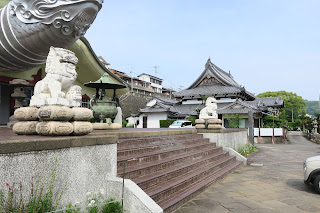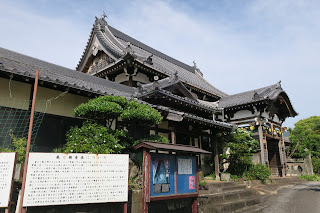Fukusaiji is an Ōbaku Zen temple in Nagasaki, Japan. Its honorary sangō prefix
is Bunshizan.
The first temple built in Nagasaki was Kofukuji, built in 1623 by traders from
the northern provinces of China, such as Jiangsu and Zhejiang. Fukusaiji, the
second temple, was founded in 1628 by members of the Nagasaki Chinese
community, predominantly merchants from Southern Fujian and their families.
It was built partially in response to the implementation of the anti-Christian
motivated tearuke system that required citizens registered to prove their
affiliation with a Buddhist temple. Temples would issue certificates that
members were not Christian and, because of the long history of Christianity in
Nagasaki specifically, the system was first implemented in Kyushu and Kyoto in
1638. The temple was built in part by the desire of the Chinese community to
confirm that they were not Christian while maintaining a separate place of
worship.
The nearby Sofukuji was constructed a few years later by the Northern Fujian
community in 1632.
The temple was completely destroyed in the atomic bombing of Nagasaki on 9
August 1945 at 11:02 am. It was subsequently rebuilt in 1979 with an 18-meter
aluminium alloy statue of Kannon, the Bodhisattva of compassion, standing atop
a spirit turtle.
|
Entering Fukusaiji Temple.
|
|
18-meter aluminium alloy statue of Kannon standing atop a spirit
turtle.
Guanyin is a Bodhisattva associated with compassion. She is the East
Asian representation of Avalokiteśvara and has been adopted by other
Eastern religions, including Chinese folk religion. She was first given
the appellation "Goddess of Mercy" or "Mercy Goddess" by Jesuit
missionaries in China.
-
The spirit turtle or spirit tortoise is a turtle originated from
Chinese mythology and spread with East Asian cultural sphere. It is
believed by East Asian cultures, like other turtles in mythology, to
represent longevity.
-
See more at
Guanyin - Wikipedia.
|
|
Guardian lions.
Komainu, often called lion-dogs in English, are statue pairs of
lion-like creatures either guarding the entrance or the honden, or inner
shrine of many Japanese Shinto shrines or kept inside the inner shrine
itself, where they are not visible to the public. The first type, born
during the Edo period, is called
sandō komainu (lit. 'entrance-road Komainu'), the second and much
older type jinnai komainu (lit. 'komainu inside the shrine').
-
Meant to ward off evil spirits, modern komainu statues usually are
almost identical, but one has the mouth open, the other closed
(however, exceptions exist, where both komainu have their mouth either
open or closed).
-
The two forms are called a-gyō (lit. '"a" shape') and
un-gyō (lit. '"un" shape') or referred to collectively as
a-un.
-
See more at
Komainu - Wikipedia.
|
|
Incense burner.
The burning of incense in Japan began during the 6th century (the Asuka
period) with the introduction of Buddhism, which uses incense during
rituals and ceremonies. Agarwood was imported into Japan from China via
Korea. From that point on, incense would become an important facet of
Japanese culture. Incense is used for a variety of purposes, including
Buddhist ceremonies, spirituality and meditation.
-
There are two major types of incense in Japan, which are either
heating or smouldering small pieces of fragrant wood, or
direct-burning incense in form of sticks or cones formed out of paste
without a bamboo stick.
-
See more at
Incense in Japan - Wikipedia.
|
|
Mizuko Jizo Statue.
The Mizuko Jizo protects the spirits of stillborn, miscarried, aborted
and newborn children in place of their parents.
-
Ksitigarbha is a bodhisattva primarily revered in East Asian Buddhism
and usually depicted as a Buddhist monk. His name may be translated as
"Earth Treasury", "Earth Store", "Earth Matrix", or "Earth Womb".
-
Ksitigarbha is known for his vow to take responsibility for the
instruction of all beings in the six worlds between the death of
Gautama Buddha and the rise of Maitreya, as well as his vow not to
achieve Buddhahood until all hells are emptied.
-
He is therefore often regarded as the bodhisattva of hell-beings, as
well as the guardian of children and patron deity of deceased children
and aborted fetuses in Japanese culture.
-
Usually depicted as a monk with a halo around his shaved head, he
carries a staff to force open the gates of hell and a wish-fulfilling
jewel to light up the darkness.
-
See more at
Kṣitigarbha - Wikipedia.
|
|
Inside Fukusaiji Temple.
Inside is a Foucault pendulum which swings over the remains of 16,500
Japanese killed during World War II and in the atomic bombing of the
city. At 25 meters, it is one of the largest Foucault pendulums in
Japan.
-
In honor of the victims of the atomic bomb, a bell is rung at 11:02 am
each day.
|
|
Zen garden.
The Muromachi period in Japan, which took place at roughly the same time
as the Renaissance in Europe, was characterized by political rivalries
which frequently led to wars, but also by an extraordinary flourishing
of Japanese culture. It saw the beginning of Noh theater, the Japanese
tea ceremony, the shoin style of Japanese architecture, and the zen
garden.
-
Zen Buddhism was introduced into Japan at the end of the 12th century,
and quickly achieved a wide following, particularly among the Samurai
class and war lords, who admired its doctrine of self-discipline.
-
The gardens of the early zen temples in Japan resembled Chinese
gardens of the time, with lakes and islands.
-
But in Kyoto in the 14th and 15th century, a new kind of garden
appeared at the important zen temples. These zen gardens were designed
to stimulate meditation. "Nature, if you made it expressive by
reducing it to its abstract forms, could transmit the most profound
thoughts by its simple presence".
|
|
Fukusaiji Temple.
«When Sakamoto Ryoma traveled to Nagasaki with Katsu Rintaro (Kaishu) in
1864, they stayed at Fukusaiji Temple. Katsu, at the time a senior naval
officer for the Shogunate, was dispatched to Nagasaki to prevent an
attack on Shimonoseki by a foreign flee. He stayed in Nagasaki for a
little over a month, from February 23 to April 4. During his stay, Katsu
visited foreign consulates in Oura, as well as other places such as the
Nagasaki Steelworks and Nagasaki Yojosho, the first Western-style public
hospital in Japan. In Nagasaki, Ryoma and Katsu also wrestled together.
The sight of the small-framed Katsu grappling with the huge Ryoma was
said to be "just like a small hawk clinging on to a crane."»
-
While a rōnin, Ryōma decided to assassinate Katsu Kaishū, a
high-ranking official in the Tokugawa shogunate and a supporter of
both modernization and westernization. However, Katsu Kaishū persuaded
Ryōma of the necessity of a long-term plan to increase Japan's
military strength in the face of Western influence that led to the
Convention of Kanagawa. Instead of killing Katsu Kaishū, Ryōma started
working as his assistant and protégé.
|
See also
Source
Location

























